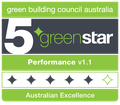As the symbol of Australia, it’s important that the Opera House leads by example. On World Environment Day the World Heritage-listed building announced a number of major sustainability achievements and projects – including a 5 Star Green Star Performance rating.
How Australia’s first heritage building secured 5 stars
The Sydney Opera House is a World Heritage listed building which is both architecturally and operationally unique. Given the building first opened in 1973, meeting on-going performance targets, particularly in water and energy, has been its greatest challenge.
As the Opera House supports many different functions - six performance venues, offices, retail spaces, commercial kitchens and restaurants and bars - targeting credit points using the Performance tool (traditionally designed for office buildings) often required it to adjust its approach and think outside the square to find solutions.
Moving from a 4 Star to a 5 Star rating was achieved by mobilising a Green Star project team for 18 months prior to certification. Led by Environmental Sustainability Manager Emma Bombonato, the team was responsible for gathering evidence of supported criteria and delivering new projects to enable SOH to achieve its 5 star rating. The Opera House also engaged a Green Star consultant to facilitate working sessions and ensure the team understood project goals and requirements to recertify and lift from a 4 Star to 5 Star rating. For the Opera House, World Environment Day was a fitting moment to show leadership in sustainability by committing to initiatives which reduce its footprint - using less energy, investing in renewable energy and maintaining its certified carbon neutral status - and inspiring greater environmental awareness in its community.
Carbon Neutral Certification
In late 2018, the Opera House achieved carbon neutral certification five years ahead of its goal. The certification was achieved by creating efficiencies in energy and waste management, streamlining day-to-day business and building operations, and offsetting remaining emissions with help from its Major Partner EnergyAustralia.
Key drivers included:
Reducing electricity use by 14% from baseline:
- Replacing incandescent bulbs in the Opera House’s Concert Hall with custom LED lights to achieve a 75% reduction in electricity consumption (2014).
- Implementing a new building management control system to monitor energy and water use and manage climate control (2017).
- Optimising the heating and cooling of the building by replacing chiller units connected to the Opera House’s pioneering seawater cooling system (2017) resulting in a 9% energy reduction.
- Increasing the Opera House’s waste recycling rate from 25% to 60%:
- Implementing a new waste management program, including the introduction of new recycling streams and transferring food waste which would have otherwise gone to landfill to an organics facility to be turned into energy (2017).
- Rolling out an educational program on waste management for onboarding staff and contractors.
Offsetting remaining emissions with help from EnergyAustralia
- Investing in NCOS-certified international emissions reduction projects and offset projects with environmental organisations Greenfleet and SouthPole. This includes supporting SouthPole’s project EcoAustralia which combines biodiversity conservation in the Annya State Forest (VIC) with international emissions reduction.
Singing from the same hymn book
The Opera House Sustainability team includes an Environmental Sustainability Manager supported by a small team of staff who assist on a project by project basis.
As sustainability touches so many corners of the organisation - food and beverage, building operations, procurement, as well as talks and performances - there are countless advocates across different departments.
The SEALs (Sydney Opera House Environment Action Leaders) are a passionate group of 15 core staff who assist engagement initiatives including staff surveys, advocacy and most recently a clean-up Australia kayaking trip
Sydney Opera House Environmental Sustainability Manager, Emma Bombonato, shares how Green Star has acted as a guide in helping the iconic landmark enhance its status as an environmental champion.
“Certifications such as the GBCA’s Green Star are setting a new benchmark for buildings to reach when it comes to improving building performance, reducing impact, engaging with end users and driving innovative and transformational change in environmental efficiency.”
“Green Star has been essential to helping us communicate our vision for sustainability.
“The rating system is simple and easy to understand for our staff and our community - when you say we’ve achieved a 5 star for Australian Excellence people get it.
“We’re continuing to set the bar higher, looking for ways to further reduce waste, energy and our overall environmental impact, while at the same time seeking to inspire action inspire our community.
“We’ve been able to generate excitement among staff by celebrating our 5 star achievement, and are working hard to take the next step to achieve 6 stars.”
This case study is part of a bigger story following the growth and innovation of SOH since 2015, with periodic check-in's on performance, including the most recent case study in 2023.
